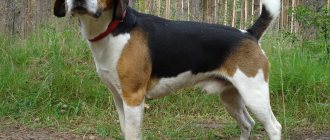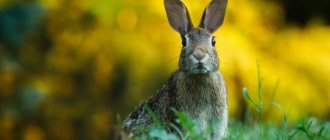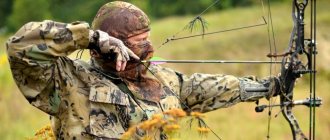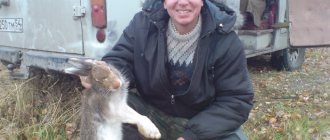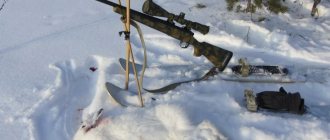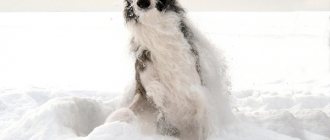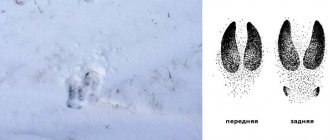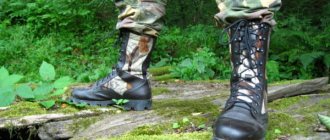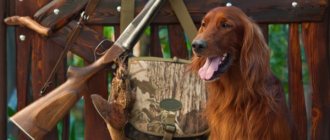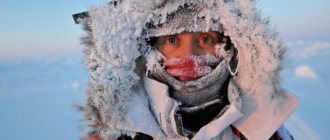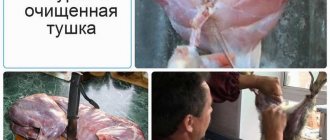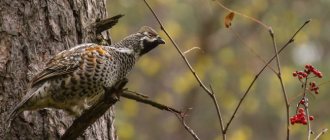Preparing for the hunt
When going into the forest, you need to decide on the type of equipment, what shot to use for a hare, and prepare a weapon. However, all this does not guarantee that the hunt will be successful. You need to have a good sense of direction in order to find the animal’s fat, understand where you can choose a hiding place and which side is best to enter from.
This is not a problem if the hunt takes place in the same place for many years in a row. But if it’s new, then you need to look for options: hire a guide, ask local hunters. Therefore, everything else should be ready for hunting and not cause headaches.
Modern industry offers many different types of equipment, weapons, ammunition and shot. The main thing is to clearly know what exactly you need.
How to shoot a hare?
Hare. Four. The fox is also very suitable for this patron of mine, there is nothing to say about the duck. For many years now I have not experienced bitter disappointment from wounded animals. Why four? This is not an absolute. The four matched my guns well. Although for MTs-21, I noticed that three is better. What does it mean? Since the times of Aksakov and Sabaneev, there has been a postulate: every gun “loves” its own shot, i.e. better, more densely, hits further with it. I completely agree with this. Tested in practice and repeatedly. So I suggest: decide on a fraction and use only it in the range 4-2, but not one or more. This is overkill, unnecessary for either the hunter or the hare. Think carefully, and you will understand that for almost all Moldavian game the fourth and third numbers of shot are more than enough. Once while hunting I watched a very confident gentleman. He shot at the hare very hotly and confidently from 100 meters. I asked him why he was doing this and what he hoped for. Apart from stupid assurances about the power of zero, I heard nothing. He's a fool. Let's not be like him. I consider shooting a hare at 50 meters even with a zero point pointless. It all starts with the cartridge case. I recommend using plastic. Paper is not reliable and breaks. But it is absolutely not suitable for semi-automatic machines. Metal is cheaper to load cartridges, but will not produce a high-quality shot. Unless you take special care of this sleeve. The main thing in it is to achieve a tight assembly of the components, and the wad for the shot must sit “deadly”, otherwise there will be no forcing, and therefore no good shot. True, the new half-containers for fractions solve this problem. But it is advisable to plant them with glue. Inspect the sleeve before assembly. The main thing is that the bottom does not completely crack, otherwise it will fly out after the charge and may get stuck in the choke, and on the next shot it will tear the barrel. These are tips for our poverty: 90% of hunters reload spent cartridges. Of course, new is new, but what can I say? The length of the sleeve is especially unimportant. Obviously it won’t be longer than 70 mm. Where do we get magnum cartridges from? A little shorter than 70 mm - they will, but it will have almost no effect on the battle. Check to see if the cartridge case is dirty, otherwise there will be no reliable rolling of the cartridge. This operation should only be done by hand. Don't chase the spin speed. Ammunition for a hare must be made very carefully, otherwise there will be little chance of taking the hare.
Capsule.
Use the regular Zhevelo, you don’t need any non-rusting ones, they are weaker. A powerful primer is a powerful cartridge. Therefore, old capsules are a disaster. How to avoid them? Buy only from a reliable supplier. The capsule should fit tightly into the socket; if it is weak, use any glue or nail polish. But for machine gunners, a new cartridge case, a tightly seated primer, is a threefold law, this is the basis for the smooth operation of the self-loading mechanism. Sometimes capsules come across with a thick bottom - this is a guarantee of misfire. Here the only hope is in God. What’s interesting: for the past 6 years in a row, out of the five hundred rounds of ammunition I stocked for the season, there has always been one misfire. One cartridge out of five hundred - what’s that? So don’t believe in the devil: three of them stopped short on a hare, and an “easy” hare at that. Such a surprise over the last three years. It’s time to be baptized when going hunting.
Types of hares in Russia
Hares are animals that live almost everywhere on earth, including Alaska and the Arctic. But in Australia and Antarctica they are not.
The following species are found in Russia:
- white hare;
- brown hare;
- Manchurian hare;
- tolai hare.
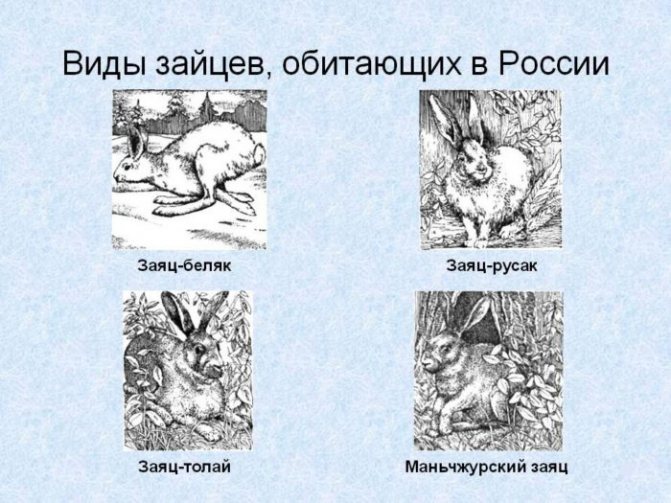
Depending on the species, the habitat of the hare can be: arctic tundra or tropical forests, deserts or semi-deserts, plains and mountains (up to 4900 m).
The most common types of hares:
- Belyak. It got its name due to the fact that in winter it changes the color of its skin to bright white, only the tips of its ears remain gray. The weight of an adult animal can reach 5 kg, length - up to 70 cm. It feeds on foliage and tree bark. Prefers to live in forests.
- Hare. Practically does not change color in different seasons. Compared to the white hare, it is larger, with longer ears and a tail. Lives mainly in steppes and fields. Weight up to 6 kg, body length - up to 70 cm.
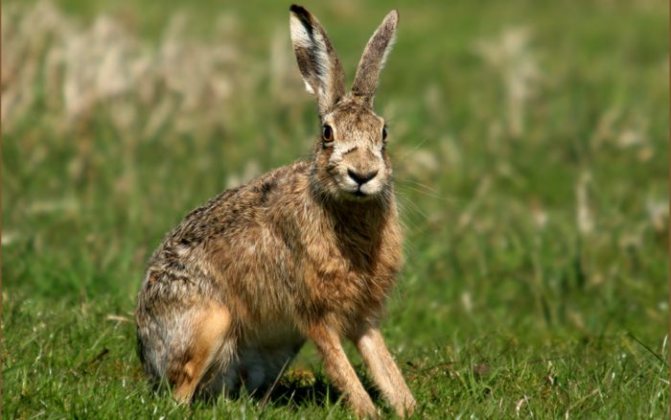
How to hunt a hare
It must be remembered that the hare is an animal with good hearing and poor eyesight. At the slightest sound that signifies danger, he begins to run away, and it’s probably not worth talking about the speed of his legs. Therefore, you need to choose the method of hunting for the “oblique” that will be most effective in order to get within shooting distance of him.
What are the different ways to hunt a hare?
- Hunting from the approach. Most often used. You can hunt in groups or alone. You need to understand where the hare’s fattening area is, that is, where it continues to look for food in winter. The point is to get as quietly as possible to the animal and not allow it to notice the hunter. Then scare away the hare and fire a shot. Although this is the most popular method, it has disadvantages. You need to know the area where you are going to hunt very well; females and young animals often become victims, since they are more careless and allow them to get close to them. This type of hunting can be practiced both in winter and autumn.
- Hunting for the Uzerka. This method also consists of tracking a hare in its roosting area. It differs from the first in that hunting takes place only during the short off-season and for the white hare. At this time, he had already changed his skin to bright white, but winter had not yet come, the snow had not fallen on the ground. The hunter must behave very quietly so as not to scare the animal. During this period, the white hare exhibits a special behavior - if there is a threat, it does not run away as fast as it can, but tries to hide. It is better to hunt the white hare in windy and damp weather, then the white hare chooses places on the edges and lies more densely.
- Hunting by tracking. They track a hare using recent tracks in freshly fallen snow. In other cases, such a hunt does not make sense.
- Drive hunting. Hunters are divided into two groups: beaters and numbers. The beater drives the animals to the number, which must shoot the hare. This method is possible with a large number of animals, but requires clear and coordinated actions of hunters. Otherwise, accidents may occur.
- Hunting from ambush. Hunting is carried out in winter, preferably on a clear night. During the day, the place where the hare is supposed to be killed is selected, and the hunter is placed in a secluded place. The distance should be no more than 20 meters, otherwise the shot will be inaccurate.

Hunting with pneumatics. In law

If earlier pneumatic weapons were perceived exclusively as children's play and entertainment for those who like to test their accuracy in a park shooting range, now everything has changed. In addition to “Izha”, many different “air guns” have appeared on store shelves, and hunting with pneumatics, which has finally almost ceased to be prohibited in our country, has received many legislative restrictions.
Ignorance does not relieve responsibility - and therefore, before purchasing this or that pneumatic weapon and thinking about hunting with pneumatics, it is worth finding out what our legislation says about this. Let's start with a simple thing - shooting from the window of a house at passers-by and cars is hooliganism. And it doesn’t matter what kind of pneumatic you have, if they catch you, they’ll break both it and you.

But it’s definitely not worth hunting people in windows with pneumatic guns.
For hunting with pneumatics, it is necessary to clarify what kind of pneumatics is a hunting weapon and requires the appropriate permit. And the “Weapons Law” is adamant here: any pneumatic weapon with a power over 7.5 J is a hunting weapon, therefore, in order to own it, you need to have a permit, and the “barrel” itself must be registered with the internal affairs bodies at your place of residence.
Typically, pneumatics with a power of 3 to 7.5 J and a caliber of up to 4.5 mm are considered sporting weapons, and a license is not required for them. However, as you might guess, it is impossible to hunt with pneumatics with such a weapon. Anything less than 3 J of power is not considered a weapon at all. But keep in mind that if they hit someone painfully on the head, you will be liable for hitting them with a “blunt object” on all counts.

Even if you don't have 3 J of power in your pneumatic, you need to handle it carefully.
In general, if you want to hunt with pneumatics, first of all look at the power of the air gun - you don’t need a permit for a weapon with a power of less than 7.5 J, but you won’t go hunting with it either. Anything between 7.5 and 25 J is already a hunting weapon, however, in order to purchase this pneumatic, you need a weapons permit and a hunting license confirming your right to hunt.
However, it is natural that the rules for handling pneumatics are not limited to the “Weapons Law”. Even if you have the appropriate permit to carry a pneumatic weapon, a hunting license, and the “pneumatic” itself is registered at the police station at your place of residence, it is worth remembering the rules of conduct when hunting with pneumatics, specified directly in the approved “Hunting Rules of the Russian Federation”.

When hunting with air rifles, it is a good idea to know not only the hunting laws, but also the rules of hunting.
The latest edition of the “Hunting Rules”, dated this year, includes the following points. Namely: the use of hunting pneumatic weapons is prohibited, “with the exception of hunting squirrels, flying squirrels, chipmunks, doves, hazel grouse, crows (gray, black and large-billed).” That is, you can only shoot the listed animals and birds with pneumatics.
Please note that even if you were just walking through the forest with a hunting pneumatic gun at the ready and you were caught in the forest without permission to carry it, everything will end very badly for you. And the only thing that will save you here is if your air gun is sheathed, and the shells are kept separately. Don’t forget, by the way, that even if you didn’t go hunting with pneumatics, you must have with you: a hunting license, a permit to store and carry weapons, and a permit to hunt in these hunting grounds (permit).

A hunting license is needed both for hunting with a firearm and for hunting pneumatics.
In addition, you need to carefully choose the place for hunting - according to the same “Rules” (and common sense), hunting with pneumatics less than 200 meters from housing is strictly prohibited. And remember - there are no concessions or discounts for the fact that this is not a “firearm”, no - if you do not comply with any rules, you will have to answer to the fullest extent of the law. Or even more serious - because proving that you came to hunt chipmunks when a bunch of woodcocks are sticking out of the bag that an unfamiliar uncle asked you to carry will be, to put it mildly, problematic.
Fedor RAKOV
What is a fraction?
Shots are lead balls that are used to fill a cartridge. It has numbers indicating its size. There is no uniform standard for marking shot sizes. In Russia and some other countries, the smaller the fraction, the larger its number. There are countries that mark the fraction backwards, so you need to pay attention to this when purchasing.
The difference between the fraction numbers is 0.25 mm
In addition to numbers, fractions have letters. They indicate the physical characteristics and method of production: soft or hard, rolled, cast or stamped.
Many hunters buy factory-made ammunition. Others make them themselves. This cartridge is called a self-roller. Some of the reasons why hunters make their own ammunition include:
- economic benefit;
- low-quality factory-made cartridges;
- I like the process of making self-rolls.

Shoot at a moving target
You can shoot at a moving target in different ways - with a leash or offhand. For such shooting you need a lightning-fast reaction and a spreading weapon. The hunter must be able to accurately determine distances within a range of up to 70m when shooting from a smooth-bore weapon; For reliable shooting from rifled weapons over long distances, you need to learn how to correctly determine distances within at least 300m.
You should always shoot, as experienced hunters say, “in moderation” and with as small pellet numbers as possible: four or five small pellets will hit the game more reliably than one or two large ones.
Rules for choosing a fraction for a hare
Choosing a fraction number is a very difficult task. If this is done incorrectly, the hunt will turn into disappointment and a painful and useless death of the game will occur.
There are recommendations for choosing a shot number depending on the territory and hunting season. Additional factors will be the experience of the hunter and the type of weapon.
Winter
The hunting season is important because the animal's pelt is much thicker in winter due to its thick fur. Small shot may not cause much harm to the hare and will simply become entangled in it. Therefore, in winter you need to choose a larger size.
In winter, No. 2 is suitable in the forest; in the forest-steppe, and if the expected shot distance is about 50 m, you need to take a larger shot - No. 1. If the hunter is experienced, has good shooting skills and a suitable weapon, then for winter hunting in open space you can choose shot with size No. 0 or No. 00.
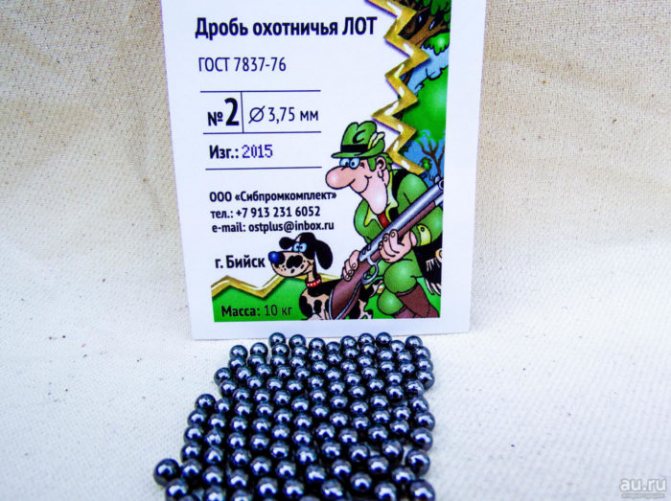
Autumn
In the fall, the hare's skin has not yet shed; finer shot will do. As for the hunting territory, the range of the intended shooting and the presence of vegetation matter. For example, when hunting in the forest, where you plan to shoot at a short distance, shot size No. 3 is suitable.
On hilly terrain with copses and bushes, you will need a larger shot - No. 2. If hunting takes place in the field, then it is better to choose No. 1, it will help in shooting at long distances.
How to hit an animal
Different animals move at different speeds, have different sizes, and so on. Based on this, it is obvious that shooting should be carried out differently. How to hit an animal and make a well-aimed shot, taking into account the specifics of a particular animal? About this in this article.
How to get a hare
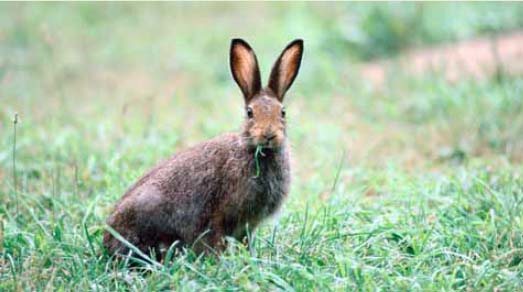
When shooting at a hare in the forest, anticipation is most advantageous, since there may not be enough time to lead and overtake. Even in a sparse forest, trees and undergrowth interfere with shooting. A shot is possible only in gaps between them, gaps, clearings, small clearings, so remember that you need a lead, a short leash, and then a shot.
A hare that jumps out from under a shooter who was hunting by tracking or along a black (motley) path goes left, right, or strictly into the chase. As a rule, it jumps out no further than 10-20 steps from the shooter, but it can also jump out right from under the feet. In this case, preemption is not required. The left and right hares are shot, aiming for the body, preferably the front or head. Those leaving strictly forward are covered with gun barrels or, as hunters say, they are shot in the ears.
How to hit the fox and wolf
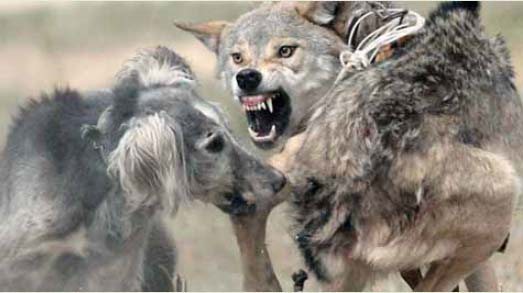
How to hit a squirrel and marten from under a husky or by tapping
The expression “getting a squirrel in the eye” is, in my opinion, quite arbitrary. Firstly, it is almost impossible to examine the eye of a squirrel sitting on the top of a spruce tree, and secondly, even if a small-caliber lead bullet with a diameter of 5.6 mm hits the eye, half of the squirrel’s head will fly off, and the skin will no longer be considered first-class. So shooting squirrels with bullets is not recommended.
When the tree is tapped, which is pointed at by the husky working on the squirrel, the animal climbs to the very top and is well projected on the top of the tree. A targeted shot with shot using lessons in shooting at a stationary target with shot will easily remove a squirrel from a tree of any height.
The marten, having eaten a squirrel, often spends a day in the last vacated nest (gain). When tapping on wood, she almost always sticks her head out of it. If at this moment you shoot a shot at a marten, then when it hits, it often falls out. But if this does not happen, you will have to either cut down the tree or climb it. So it’s better to wait until the animal crawls out of the nest completely, and then shoot, aiming for the head, in order to spoil the valuable skin as little as possible.
How to hit roe deer with buckshot
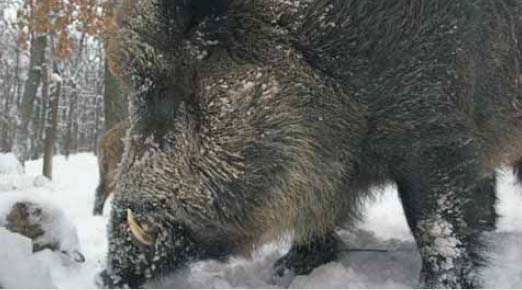
I had to hunt roe deer a lot in Germany. In my opinion, this is the fastest and most difficult animal to shoot. Shooting roe deer with buckshot is prohibited abroad, but some of our hunting grounds allow shooting in pens with small buckshot.
While running, a roe deer not only moves quickly, but also simultaneously makes vertical jumps. Buckshot, to some extent, due to the width of the spread, compensates for the difficulty of aiming and aiming at the target. But I am categorically against shooting at animals with medium and large buckshot: too many wounded animals are killed, subsequently dying uselessly and painfully.
How to hit deer and wild boars from a tower
This is a fairly common hunt in Russia. Quietly and without sudden movements, sitting on a tower or seat, that is, a storage shed, the hunter has the opportunity to calmly select a certain trophy, carefully aim at the most lethal place and shoot. Although, of course, there are quite a lot of killing spots on the body of a large animal, it is enough to point the front sight or crosshairs at the side of a boar, deer, or slightly behind the shoulder blade - and you can be sure that the animal will not go far after the shot. But it should be remembered that when firing a bullet at a stationary target, it is completely unacceptable to pull or pull the trigger. The slightest lateral force on it takes the bullet away from the aiming point.
As we know, when grazing animals are on the move almost all the time. Therefore, when you notice that the animal has moved off, refrain from shooting or make a short leash after it and shoot at the moment of tracking. Believe me, it's not that difficult. There is a much greater chance of scaring off a sensitive animal with a careless movement or knock. In this case, an instant lead behind the fleeing animal and a targeted shot at the body without preemption are necessary. The possibility of the animals returning to their original place is unlikely, so they should not be released. It should, however, be remembered that a shot from a tower or storage shed is made from top to bottom, so the aiming point on the animal’s body should be slightly higher than with a direct shot from the ground. A bullet, piercing the body of a deer or wild boar from top to bottom at an angle, will precisely hit the central internal organs.
How to hit elk, wild boar, deer and roe deer during a driven hunt with smooth and rifled bullets
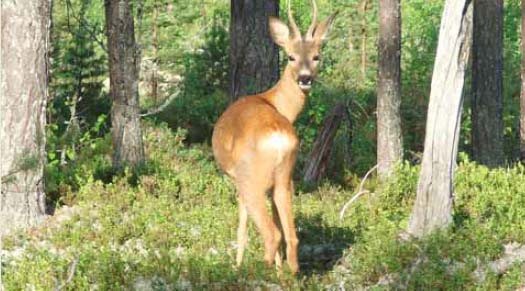
An error in aiming can be determined visually after a shot by following the fountain raised by a bullet in the snow or on the ground, and then making an appropriate adjustment for the second shot. German hunters use a whistle when hunting in open spaces. I myself watched how, after the hunter’s whistle, a rushing roe deer instantly stopped in the middle of the field and was shot at point-blank. But I myself have not tested this method in practice.
The rifle chain itself is built in the middle of the forest, along a road or a narrow clearing. It consists mainly of shooters with smooth-bore guns, who shoot at a distance of up to 45 m (according to the rules). The hunter, standing on the number, first of all outlines possible sectors of fire: clear gaps between trees, sightings, animal trails, all kinds of openings. Shooting through tree branches or bushes is ineffective, since the bullet can deviate from the trajectory at the slightest contact with them. A hunter usually notices a large animal (elk, wild boar, deer) walking ahead of time, before it approaches for a shot, or even hears its approach. When you see or hear an animal, you can raise your gun in advance to avoid the butt catching on your clothes and not to scare off the animal when it is nearby. Having launched it at a sufficient distance for a sure hit, you should select a clean gap from those previously planned and, quickly pointing the front sight at the killing spot, shoot with virtually no anticipation. In an area where shooting is permitted, in the forest, in most cases it is not necessary.
Shooting in the forest with a leash is not recommended, since the likelihood of a bullet hitting a tree or other obstacle is too high. As we already know, time passes from the moment the decision is made to shoot until the bullet hits the target. The hunter, unwittingly, risks getting into an obstacle in the path of the animal, since when shooting with a leash, the gun continues to move. How to be? You don’t have to shoot an elk or a wild boar from the moment it appears, but wait for the animal to approach at the intended location of the shot (it’s not difficult to guess), pointing the gun there in advance. When the animal changes direction, there is always time to throw the gun in a different direction.
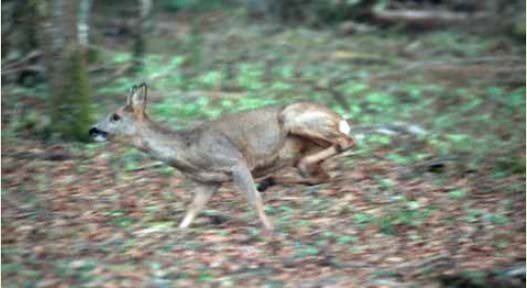
How to hit a roe deer
The animal is relatively weak to wound, and hitting it with a heavy 12-gauge lead bullet will not allow it to escape, even if vital organs are not hit. On the other hand, this is the fastest-footed animal, so it is very difficult to hit the target accurately. My advice: pull the trigger as soon as the “meat” of the running goat is on the front sight. The opportunity to target her more accurately may not present itself.
Intuitively, the hunter points the fly at the largest part of the animal’s body – the front part of the body. She is also the most lethal.
In my memory, all the ungulates that were beaten on the body in the area of the shoulder blade went to the hunters. Of the two mouflon stags I caught during a driven hunt, one received a bullet from a smoothbore gun in the heart, and the other in the sacrum. Both remained in place after the shots, but the second trophy can be classified as accidental. Of course, you shouldn't aim at the sacrum. A deer or elk running straight at a hunter needs to aim straight at the chest - this is a killing shot. But a wild boar, which is shorter than a man, can be shot in the middle of the forehead. At close range, a smooth bullet can easily pierce the skull of a boar of any size, and a rifled one even more so.
Table 1
Movement speed and some characteristics of birds and animals necessary for calculating and selecting a fraction number
| Names of birds and animals | Average driving speed | Case length, cm | Weight, kg | ||
| m/s | km/h | average | maximum | ||
| Teal | 20,0 | 72,0 | 25—30 | 0,2—0,5 | 0,6 |
| Snipe | 15,3 | 55,0 | 30 | 0,108 | 0,125 |
| Woodcock | 7,0 | 25,0 | 34—36 | 0,375 | 0,45 |
| Great snipe | 7,0 | 25,0 | 20 | 0,12 | 0,15 |
| Mallard duck | 16,0 | 57,5 | 50 | 1,0—1,5 | 2,0 |
| Goose (gray) | 22,0 | 79,2 | 90 | 2,6—4,5 | 5,0 |
| Grouse | 8,3 | 30,0 | 45 | 1,6 | 1,7 |
| Capercaillie | 15,0 | 54,0 | 90—112 | 1,5—5,5 | 6,5 |
| Grouse | 6,5 | 23,0 | 35 | 0,46 | 0,58 |
| Pigeon | 16,7 | 60,0 | 42 | 0,52 | 0,62 |
| Bustard | 15,0 | 54,0 | 100 | 4—5 | 6,5 |
| Pheasant | 8,3 | 30,0 | 60 | 1,2 | 1,5 |
| Quail | 11,0 | 40,0 | 15 | 0,11 | 0,12 |
| Partridge | 9,7 | 35,0 | 40 | 0,45 | 0,5 |
| Crow | 14,0 | 5,05 | 47—50 | 0,7 | 0,75 |
| Hare | 8—10 | 28—36 | 60 | 4—6 | 7,0 |
| Elk | 4 (trot) | 14,4 | 250—300 | 450—500 | 600 |
| Deer (deer) | 4 (trot) | 14,4 | 300 | 150—200 | 250 |
| Boar | 4 (trot) | 14,4 | 200 | 80—150 | 320 |
| Roe | 3 (trot) | 10,8 | 140 | 30—50 | 60 |
| Saiga antelope | 14—15,3 | 50—55 | 130—135 | 37,0 | 40 |
| Fox | 3 (trot) | 10,8 | 60—90 | 5—8 | 10 |
| Wolf | 3 (trot) | 10,8 | 170 | 65—70 | 80 |
| Raccoon dog | 3 (trot) | 10,8 | 85—95 | 9 | 12 |
S. Losev. Magazine "MASTERGUN" No. 151
Using different types of shot in ammunition
Many experienced hunters combine cartridges with different types of shot when loading their guns. This is done in order to simultaneously take into account several options for the development of events during the hunt. If the hare is at a great distance, he was scared away too early, then a larger shot from the second cartridge will help to penetrate to a greater distance. The same thing, if the hare is too close, you will need a smaller shot size.
Double-barreled shotgun
It is considered the best type of weapon for hunting hare, since usually only two shots can be fired. If you manage to shoot the third one, then only to finish off the animal. Typically 16 and 12 gauge shotguns are used.
If they want to combine shot, then one cartridge is loaded for short-range shooting, the second for long-range shooting. Typically, shot numbers are used: for a short shot - No. 2 or No. 3, for a long shot - No. 1 or No. 0.
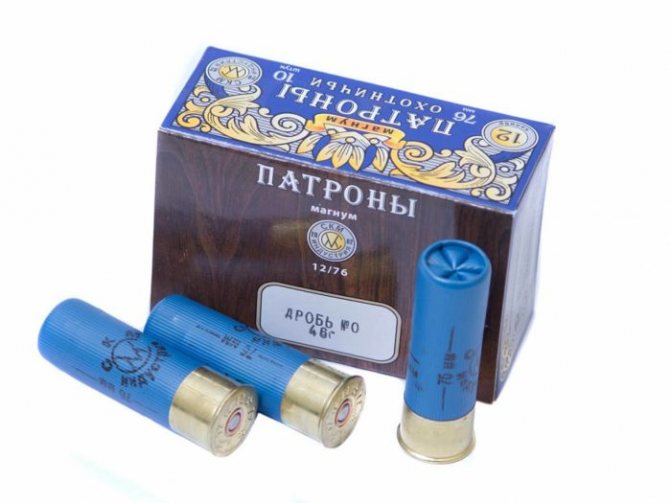
If a double-barreled shotgun has a different choke, then the narrow one is loaded with small shot, the wider one is loaded with larger shot.
Automation
Since in semi-automatic weapons shots are fired one after another, the shot combination is performed in this way: the first cartridge is loaded with shot of caliber No. 2-3, then increased to No. 0. This is done on the basis that the shot distance will increase all the time and it will be necessary to shoot at someone who is already running away hare
Shooting a hare
The hare, as you know, is a nimble and quite unpredictable animal. A shot at a hare is fired when the animal runs out of the pen, or runs from under the hound or from under the hunter himself. When hunting without a dog, using the so-called self-propelled gun, the hare is also shot from an explosion. From under the hound or from the corral, the hare moves towards the hunter or, as an option, sharply moves to the side.
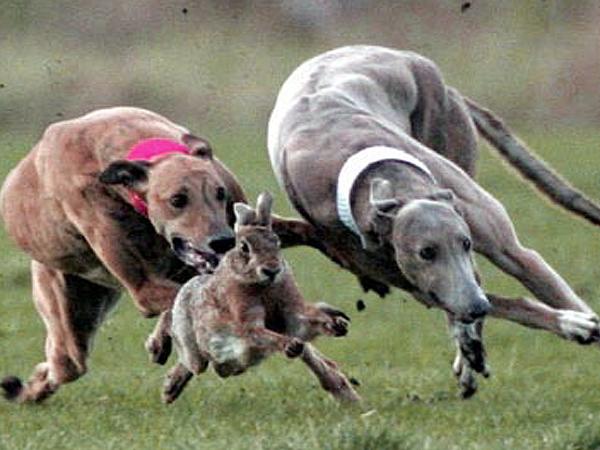
Hare and hounds
If a hare comes at a hunter, you should aim at the area of the animal’s front paws. In this case, you can shoot without a leash, offhand.
If the hare runs sideways, the shooting technique will depend on the distance and behavior of the animal. If the hare is at a distance not exceeding 40 m and moves in small jumps, you need to shoot directly at the front of the hare's body, perhaps with a slight lead. If the hare moves in large strides, a lead of 2–3 lengths will be required.
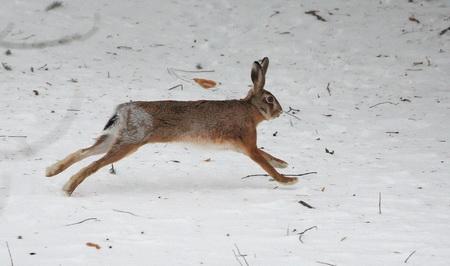
When a hunter shoots while “overtaking”, it is recommended, holding the hare at sight, to go forward and shoot as soon as there is sufficient clearance for this. This shooting technique is best used when hunting hare in the field if the hare is at a great distance. When hunting hare in the forest, it is most effective to use lead, since there is usually not enough time for leash and overtaking. Even if the forest is not very dense, trees and undergrowth constitute an obstacle for the hunter. In the forest, shooting is possible only in gaps between vegetation, in gaps and clearings, as well as in clearings.
Shooting at a hare in the forest is done as follows: first a lead, then a short leash, followed by a shot.
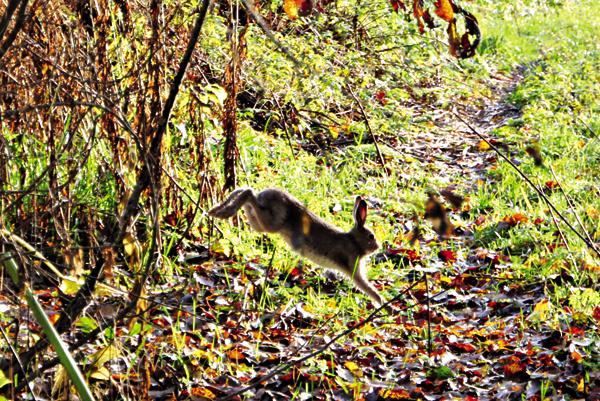
Hare in the forest
In cases where hunting is carried out by tracking or along a black trail, the raised hare runs to the right, to the left, or runs straight away from the hunter, that is, into the chase. In most cases, the animal appears quite close to the hunter, no further than 10 - 20 steps, but it happens that the hare jumps out right from under his feet. In these situations, shooting lead is not required. You should shoot at a hare running to the right or left, aiming at the body; it is best to aim at the front of the animal’s body or the head. If the animal moves straight forward, it is most effective to cover the target with the trunks or aim at the tips of the ears.
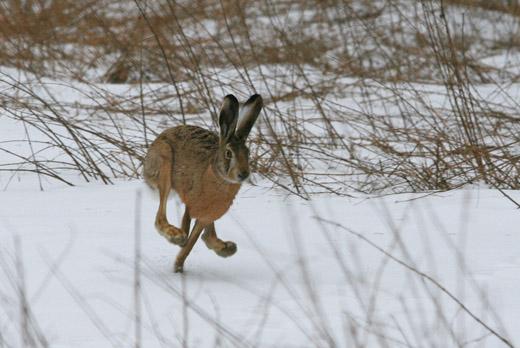
The hare runs towards the hunter
They also shoot at a sitting hare. It is considered good form to raise the animal by shouting something, and then shoot directly “at the hijack” or from the side, “at the half-hijack”. It is best to shoot at a hare sitting motionless by aiming at the front of the body or the head. If the distance to the target does not exceed 45 m, it does not matter what position the animal occupies.
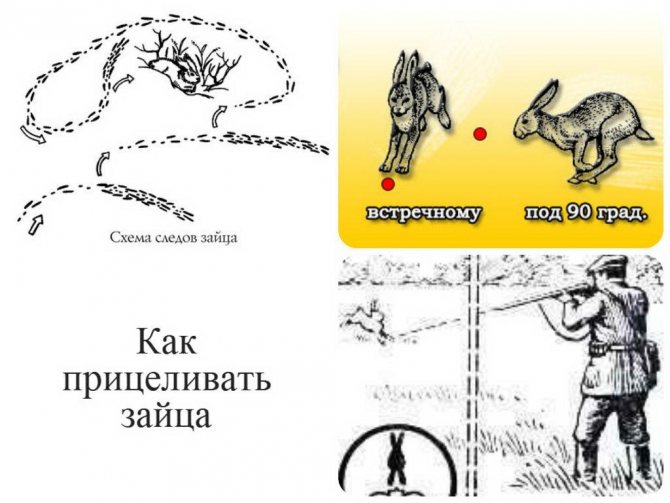
Scheme of aiming at a hare
If the hare is at a long distance, it would be more correct to wait until the animal turns sideways towards the hunter.
In this case, it is not recommended to shoot at a hare with its back turned or, on the contrary, “facing” the hunter: since the cross-section of the hare’s body is very small, and the shot will most likely fly past the target.
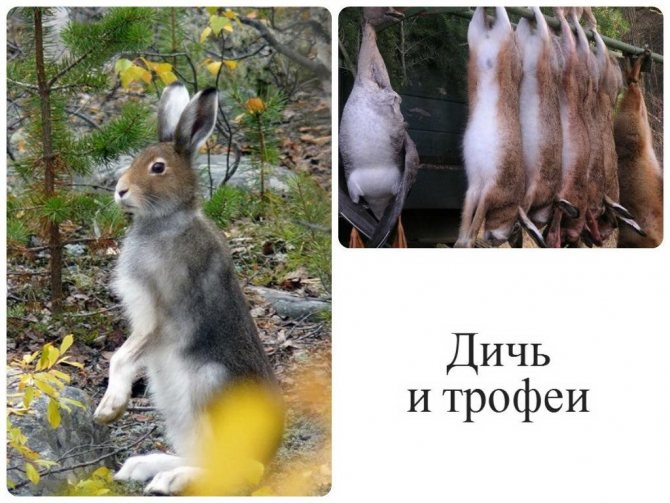
Hares
It should be added that it is not customary to shoot a hare while lying down; this is contrary to the “moral code” of the hunter.
Which gauge is more effective: 12 or 16
In order to figure out which caliber to choose, you need to understand what the fundamental difference is. The fact is that, under equal conditions, a larger caliber will always have a greater shot density and, accordingly, lethality at a long distance.
In addition, there is a much wider selection of cartridges on the market for 12 gauge than for 16. Taking this into account, 12 gauge turns out to be universal, suitable for hunting conditions in the forest and field.
